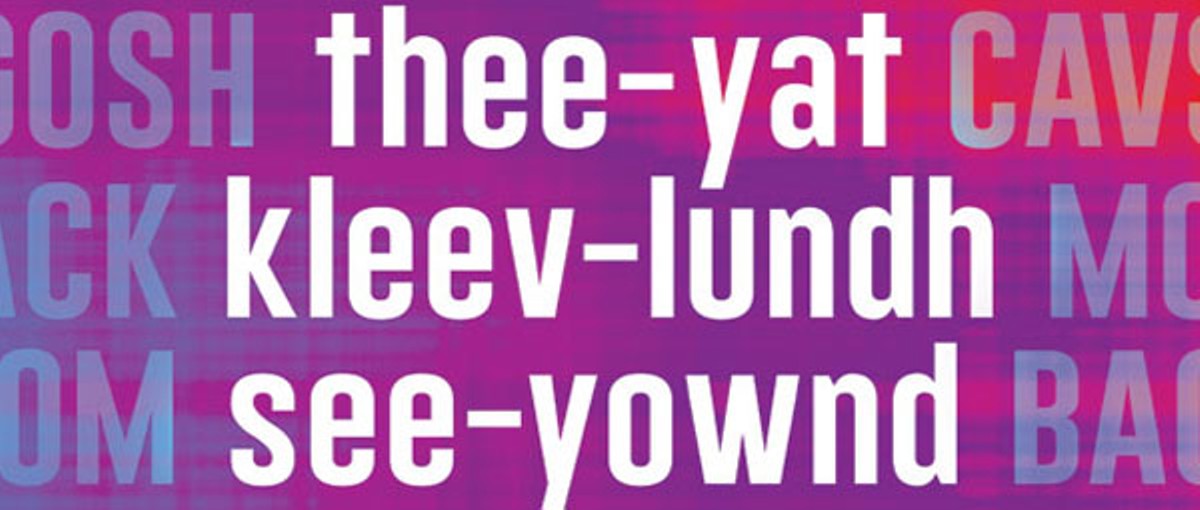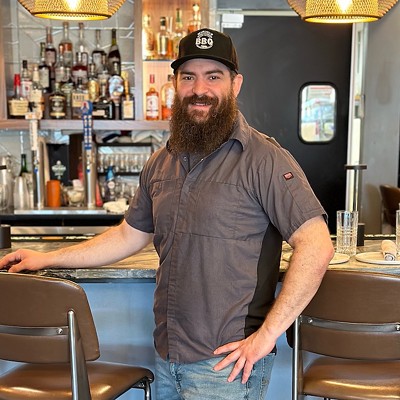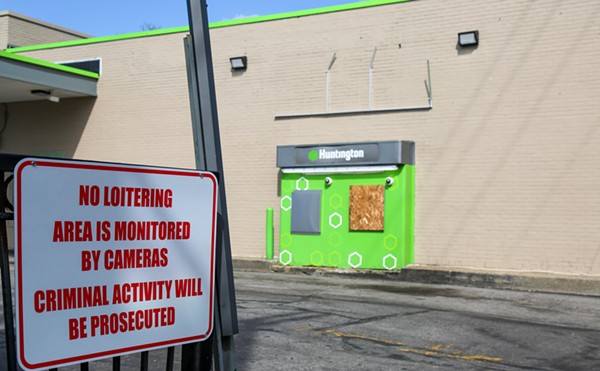Until Bridget VanDenHaute started college, no one had ever told her she sounded funny when she talked. Growing up near Medina in Hinckley Township, she'd rarely been around anyone who spoke any differently than she did. But in 2011, she moved to Athens to attend Ohio University and noticed the accents immediately. She heard the subtle Southern lilt of Cincinnati, the brusqueness of southeastern Ohio Appalachia, and the head-scratching yinz from OU's Pittsburgh contingent.
Only she was the one who got teased.
"It started right away, and at least at first, it was constant," VanDenHaute, now 24, says today. "Before college, I guess I was a bit of a homebody and never really went that far away. No one had ever brought up how I sounded before."
It was the worst in the dorms. For the first couple of years, a week would rarely pass when someone didn't point out her hard, nasally a's or her short o's, which sounded as though they were coming from all the way in the back of her throat and, somehow, sounded more like an a.
"I heard it all the time," she remembers. "'Say mom!' or, 'Say lasagna!' and I'd do it and they'd laugh. "A lot of the time it was from my friends who were from Columbus or Cincinnati — who I thought sounded funny. But I'd get it from people who weren't from Ohio too. Those were the ones who really pissed me off. You want to say, 'You're the ones who sound different, not me!'"
Then, one day, she did.
One night while out at the bars, after being asked about her accent for what felt like the millionth time, she took to Twitter and fired off what may as well be a rallying cry for Northeast Ohioans who feel just like her: "Im sick of being told i have an accent," she wrote. "Bitch, im from cleveland, you have the accent."
Talk to people from all over the Greater Cleveland area and you'll hear two things: A distinct Cleveland accent (sorry, folks), and a chorus of denials that such an accent exists. So let's first dispense with the fiction that Clevelanders don't speak in a way that is noticeable to anyone who grew up elsewhere, including other regions of Ohio. We do. And it is. How it got here, how it developed, and how it has spread over time has fascinated linguists for years. And as it turns out, Cleveland is one of a dozen or so cities along the Great Lakes that have, over the past half century, been part of the largest transformation of spoken English in more than a thousand years.
In the late 1960s, a linguist at the University of Pennsylvania named William Labov began noticing a series of changes in vowel pronunciations among speakers in the Midwest. He would eventually call these changes the Northern City Vowel Shift, later abbreviated to the Northern Cities Shift, known in linguistic circles as simply NCS. The pocket of the country that is home to this shift — called the Inland North Region — stretches from Syracuse, New York, in the east to Milwaukee in the west, and includes some areas from Green Bay in the north to St. Louis in the south. Other major cities in the NCS region include Chicago, Madison, Toledo, Detroit, and, you guessed it, Cleveland. In all, it's a territory of more than 88,000 square miles containing more than 34 million English speakers who, today, likely sound drastically different than their great-grandparents did.
The Northern Cities Vowel Shift is an example of what linguists call a "chain shift," and in this case, it all starts with the short 'a' sound. As Labov wrote in The Politics of Language Change: Dialect Divergence in America, "The initiating event appears to be the shift of short-a in bat to ... sound very much like the vowel of yeah. It is not just this one word, bat ... but all words spelled with short-a: cad, bad, that, cat, attitude, cap, happen, happening, etc."
What this means is that speakers in Cleveland, and elsewhere in the NCS region, are almost adding an extra syllable when we say those words and others like them. To use Labov's example, if you insert the word "yeah" into the middle of the word "cat," you come up with something that sounds like "c-yeah-t" (or kee-yat).
***
While this dialect shift wasn't detected until the 1960s, linguists believe it has roots that go back as far as the construction of the Erie Canal, which, in the mid-19th century, brought tens of thousands of immigrants from the East — especially the Northeast — to various points along what we now know as the Rust Belt.
By the beginning of the 20th century, cities like Cleveland, largely populated by Yankees who had moved from New York and New England to settle the Western Reserve, had become home to tens of thousands of Irish, Italian, German, and Eastern European immigrants. Each brought their own language and a modest understanding of English to a region already populated by settlers who spoke a Northeastern version of American English. Something had to give.
"Language is going to change pretty quickly when you get all these non-native speakers together," says Dennis Preston, who teaches sociolinguistics and perceptual linguistics at Oklahoma State University.
These new, non-native speakers from the East especially struggled with what is called the "low front vowel," or the short 'a' sound heard in words like bag, cat and hat.
"That vowel didn't exist in any of their native languages, so they did what any of us would do — they went for what sounded closest," Preston says.
So among the growing immigrant population, hat became something closer to hot, cat became cot, and so on. Not surprisingly, the native speakers who were already there mocked them.
"They'd open their mouths and get laughed at and called dagos and polacks," Preston says. "So that first generation wanted to rid themselves of this accent, but then the second generation came along and started to overcorrect. Instead of replacing 'hat' with 'hot,' they started saying 'h-yeah-t.' This triggered the whole rotation."
Once the short a sound began to change, the other vowels fell like dominoes. The shift in the 'a' sound created something of a phonetic vacancy in our mouths. So to fill that void, the vowel sound in the word "cot," for instance, slid forward, and eventually we were saying cat to mean that extra bed a hotel offers when you have three or more people in your room. Pretty soon, our c-yeah-ts were sleeping on our cats.
Welcome to Cleveland.
You'll rarely find a native of New York, or Boston, or Texas who is unaware of how the rest of the country hears his speech. Clevelanders, on the other hand, tend to be more like VanDenHaute. Most people in Northeast Ohio seem either oblivious to their native and natural dialect, vigorously defensive of what they believe is their "normal speech," or some combination of both.
I was talking recently with an acquaintance of mine at the eastside pub where he works as a bartender. He conceded that there is certainly a Cleveland accent, but is adamant that he doesn't have one (he does). This bartender, who asked that I not use his name, grew up in Mayfield, but went to college in the South and lived there for several years after. His accent is subtler than most Clevelanders', and, perhaps not surprisingly, it now works in concert with the slight drawl he picked up in his years below the Mason-Dixon line, but it's there. Because of course it is.
As we conversed over drinks, a couple of men at the other end of the bar started listening.
"We don't have an accent," one interjected eventually. He said he used to live out West and when people would tell him that he "talked funny" he'd tell them they were crazy. "The Midwest is where there is no accent."
His friend jumped in: "No, I think there's a Midwest accent, but we don't have it here in Cleveland. There's no such thing as a 'Cleveland accent.' People say that all the time, but it's a Midwest accent. Go to Chicago or Detroit. It's there."
"You don't hear it here too?" I asked.
"I hear how we talk," the first man said. "And we talk how we talk. But it's not an accent."
Very well, then.
Those late-night barflies aren't alone. I recently mentioned to my mother, who was born in southern Indiana but raised mostly in northwest Ohio, that I was working on an article about the "Cleveland accent." She replied: "But people from Ohio don't have an accent."
Linguists and voice scholars who have studied Midwest speech have all come across this phenomenon, which they say is more or less unique to Clevelanders and our Rust Belt brethren.
"People here honestly don't hear it," says Shannah McGee, a voice production specialist at Case Western Reserve University. "Everyone says, 'Well, I don't have an accent.' I say, 'Of course you do!' There's this myth that the Midwest is where there is no discernable accent, but that's just not true."















